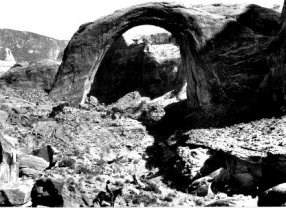
By its wonderous size, to say nothing of its majesty and mystery, Rainbow Bridge has inspired humans throughout time. From the time the bridge became known to the outside world in the early twentieth century, thousands of people from around the world have visited each year. From its base to the top of the arch, it is 290 feet-nearly the height of the Statue of Liberty-and spans 275 feet across the river; the top of the arch is 42 feet thick and 33 feet wide.
Tucked among the rugged, isolated canyons at the base of Navajo Mountain, Rainbow Bridge was known for centuries by the Native Americans who lived in the area.Native Americans living in the region have long held the bridge sacred. Ancestral Puebloan residents were followed much later by Paiute and Navajo groups. Several Paiute and Navajo families, in fact, still reside nearby. By the 1800s, Rainbow Bridge was also surely seen by wandering trappers, prospectors, and cowboys. Not until 1909, though, was its existence publicized to the outside world. Two separate exploration parties-one headed by University of Utah dean, Byron Cummings, and another by government surveyor, W.B. Douglass-began searching for the legendary span. Eventually, they combined efforts. Paiute guides Nasja Begay and Jim Mike led the way, along with trader and explorer, John Wetherill. Men and horses endured heat, slickrock slopes, treacherous ledges, and sandstone mazes. Late in the afternoon of August 14, coming down what is now Bridge Canyon, the party saw Rainbow Bridge for the first time. The next year, on May 30, 1910, President William Howard Taft created Rainbow Bridge National Monument to preserve this "extraordinary natural bridge, having an arch which is in form and appearance much like a rainbow, and which is of great scientific interest as an example of eccentric stream erosion." After the initial publicity, a few more adventurous souls journeyed to Rainbow Bridge. Teddy Roosevelt and Zane Grey were among those early travelers who made the arduous trek from Oljeto or Navajo Mountain to the foot of the Rainbow. Visiting Rainbow Bridge was made easier with the availability of surplus rubber rafts after World War II, although the trip still required several days floating the Colorado River plus a 7-mile hike up-canyon. By the early 1950s, people could travel by jet boat from Lees Ferry, then make the hike-a trip totalling three days! 
What Teddy Roosevelt and his contemporaries witnessed-evidence of the significance of Rainbow Bridge to early and present day Native American cultures-is difficult to discern today. Since then, much archeological evidence has been lost as Lake Powell, along with thousands of visitors, arrived. The Glen Canyon Dam was authorized in 1956. By 1963, the gates on the dam closed and rising Lake Powell began to engulf the river and its side canyons. Higher water made access to Rainbow Bridge much easier, bringing thousands of visitors each year. In 1974, Navajo tribal members who lived in the vicinity of Rainbow Bridge filed suit in U.S. District Court against the Secretary of the Interior, the Commissioner of the Bureau of Reclamation, and the Director of the National Park Service. The suit was an attempt to preserve important Navajo religious sites that were being inundated by the rising waters of Lake Powell. The court ruled against the Navajo, saying that the need for water storage outweighed their concerns. In 1980, the Tenth District Court of Appeals ruled that to close Rainbow Bridge, a public site, for Navajo religious ceremonies would violate the U.S. Constitution which protects the religious freedom of all citizens. By 1993, a National Park Service General Management Plan, involving much public input, was adopted. It offered a long-term plan for mitigating visitor impacts and preserving the resources of Rainbow Bridge National Monument. As part of the planning process, the National Park Service consulted with the five Native American nations affiliated with Rainbow Bridge: the Navajo, Hopi, San Juan Southern Paiute, Kaibab Paiute, and White Mesa Ute. Chief among their concerns was that Rainbow Bridge-a religious and sacred place-be protected and visited in a respectful manner. Additionally, the tribes expressed concerns about visitors approaching or walking under the bridge.Today, the National Park Service simply asks that you visit this site in a manner respectful of its significance to the people who have long held Rainbow Bridge sacred. While Rainbow Bridge is a separate unit of the National Park Service system, it is managed by another NPS unit, Glen Canyon National Recreation Area. |
Last updated: April 17, 2025
